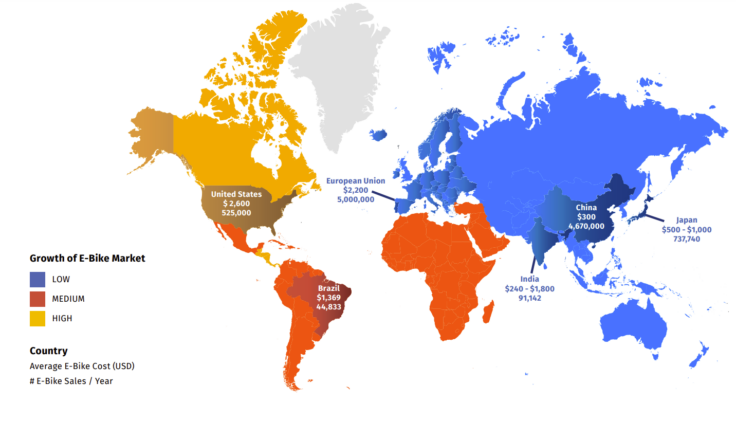March 12, 2024
Why We Need E-Bikes As A Climate and Mobility Solution
People in cities all around the world have been seeing a surge in a new phenomenon on their streets: electric bicycles, or e-bikes.
Download ITDP’s “E-bikes: Charging Towards Compact Cycling Cities” report.
Whether branded as part of a larger bikeshare program or a personal tool, the popularity of e-bikes was jump started over the past few years by the restrictions of the COVID-19 pandemic. The global e-bike market has now been valued at more than $40 billion USD in 2023, and is expected to grow even more as more people, especially urban residents, recognize their potential for daily travel, goods and services delivery, and leisure.
E-bikes are particularly close substitutes for cars, two-wheelers, and motorcycles because they can cover longer distance trips with less effort, relative to traditional pedal bikes. Thus, e-bikes will have a significant role to play in shifting people away from high-polluting private vehicles.
While the e-bike surge is being hailed as a new frontier for electric micro-mobility, many governments and cities have yet to clearly define what e-bikes are, what quality standards they must meet, and where and how they can be used safely and efficiently. This has led to confusion for potential e-bike riders and retailers, particularly as concerns about the hazards of lithium ion batteries in two-wheelers grows. Thus, clearer manufacturing guidelines and criteria are important for governments to put into place as we look towards the future of e-bikes.

For e-bikes—and cycling more broadly—to be viewed as a safe and dependable alternative to cars, it is crucial that we take the guesswork out of owning and operating them. Given their cost-effectiveness, accessibility, and efficiency, there is certainly ample potential for cities to reap the environmental, social, and economic benefits of the e-bike boom.
To help cities and planners better understand the steps to take to maximize the potential of e-bikes, ITDP has released a new report, developed with support from the Climateworks Foundation, entitled E-bikes: Charging Toward Compact Cycling Cities. Drawing on data gathered from interviews with global e-bike experts and other in-depth research, this paper offers the first global analysis of how e-bikes are being used and what a large-scale surge in usage could mean for the climate and for local communities. It also aims to define what e-bikes are (and are not) and evaluate how they are currently being used, their benefits, the challenges to adoption, and what governments can do to adapt.

Learn more about ITDP’s global Cycling Cities campaign.
Notably, the report offers a clear definition of e-bikes as electrically powered two- and three-wheeled cycles that are compatible in terms of size and maximum speed with conventional (non-motorized) bicycles. E-bikes are clearly differentiated from faster, heavier electric two-wheelers, mopeds, and motorcycles. This differentiation is particularly helpful when considering where certain modes can be ridden—for the most part, e-bikes should be able to use cycle lanes while faster modes should not.
The report positions e-bikes as a critical element to making cities more livable and equitable due to their potential to replace a large share of vehicle trips and reduce related emissions and congestion. The report identifies the individual countries with the largest emissions reductions potential as India and the United States, where a switch to e-bikes could take more than 40 million private vehicles (cars and two-wheelers) in India, and 8 million cars in the US, off of the road.

Demand and interest in e-bikes also present an opportunity for domestic manufacturing and economic development. With the global e-bike market already in the billions, it currently makes up about 15% of the market for all electric vehicles and is poised to grow. Thus, the associated industries for the development, maintenance, and deployment of e-bikes have significant potential to spur job and economic growth. Many large countries—including Japan, Brazil, the US, Australia—are experiencing a rapid rise in demand for e-bikes and can harness these diverse benefits.
Governments should view e-bikes, and cycling more broadly, as an important piece of a comprehensive sustainable transport network. For national and city governments to further reap the rewards of e-bikes, however, they need to take concrete steps to address existing barriers to access, affordability, and safe use for all cyclists. This includes the implementation of infrastructure that separates people on e-bikes and bicycles from higher-speed vehicle traffic. Cities should also collaborate with bikeshare operators to deploy shared e-bikes and charging infrastructure, a good option for people to easily try an e-bike. For those who want to own, governments can also provide incentives to make e-bikes more affordable to purchase, similar to those provided for electric vehicles.

Equitable access also requires that governments educate and engage low-income and wage-based e-bike users (such as food delivery workers) who rely on them in the day-to-day. Beyond the city level, stronger oversight at national levels will be key to establishing important quality standards, road safety measures, and climate targets with e-bikes in mind. In addition, governments need to ensure that key resources on road safety, purchase subsidies, maintenance, and beyond are made widely accessible to all existing and potential e-bike users. As the technology and availability of e-bikes develops, it is clear that they are here to stay as a key component of the future of sustainable transport.
What is needed now is for stakeholders in both the public and private sectors to take the necessary actions to create infrastructure and policies that will help ensure all urban communities and cyclists can benefit from this momentum.
